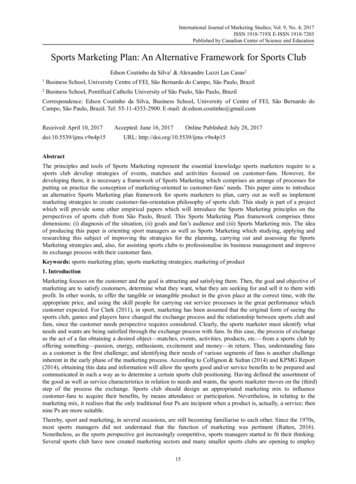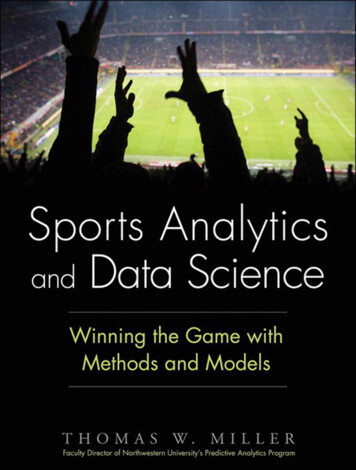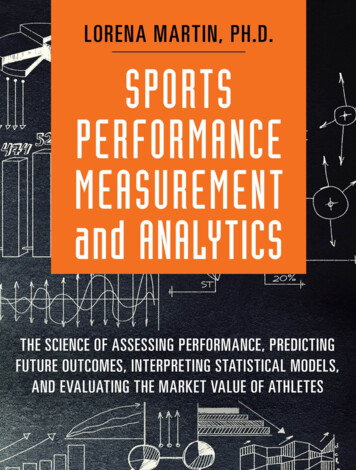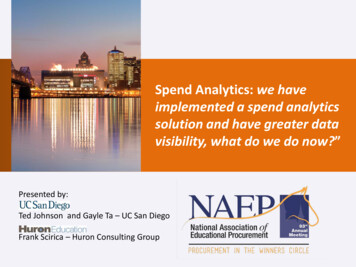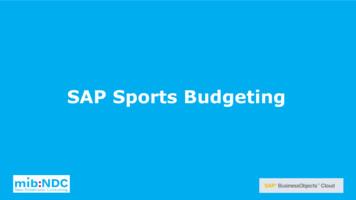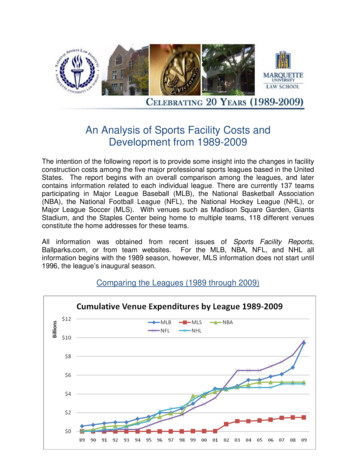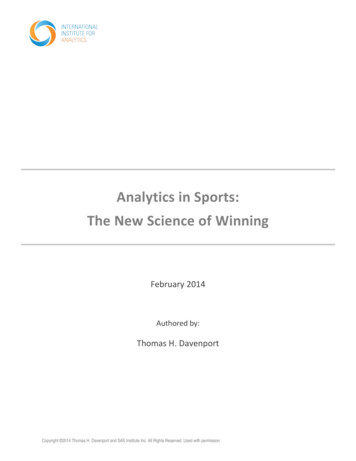
Transcription
Analytics in Sports:The New Science of WinningFebruary 2014Authored by:Thomas H. DavenportCopyright 2014 Thomas H. Davenport and SAS Institute Inc. All Rights Reserved. Used with permission.
IntroductionMany industries today are adopting more analytical approaches to decision-making. However,no other industry has the same types of analytical initiatives underway as the domain ofprofessional sports. That sector has the following attributes:1. Customers are as analytical—and sometimes more so—about the industry’s product asthe industry itself, endlessly debating metrics, statistical analyses, and implications forkey decisions online and in fantasy leagues;2. There are multiple analytical domains to address, including game and playerperformance, player selection, customer relationships, business management, injuryprevention, and so forth;3. The industry has multiple output channels for its analytics, including internal analysis byteams, direct use by fans and fantasy league players, data and analytics websites, videogames, and broadcast analysis and commentary;4. The industry’s work with analytics has been celebrated in popular articles, books andmovies (Moneyball and other works by Michael Lewis in particular);5. The amount of data available—both big and small—is mushrooming, from game videoto location sensors to online scouting reports;6. The rapid movement of coaches and general managers from one team to another hasled to a viral transmission of analytical ideas across leagues;7. The major conference for sports analytics, sponsored by MIT, has grown from 175attendees at the inaugural event in 2007 to over 2200 in 2013.Despite this evidence of impressive activity and growth, the use of analytics in sports is notwithout its challenges. Foremost among them is the traditional culture of many teams.Relatively few owners, managers, coaches, andplayers pursued careers in professional sportsDemand from key decisionbecause of their interest in analytics. Even whenmakers for sports analytics isconsiderable data and analytics are available toconsiderably less than thesupport key decisions, they may not employ themsupply of data, technology, newover their intuition and experience. In short, demandmetrics, and analytics.from key decision-makers for sports analytics isconsiderably less than the supply of data,technology, new metrics, and analytics.Another problem for the industry that restricts the wholesale adoption of analytics is thatprofessional sports teams are, by and large, small businesses. A 2012 analysis suggested thatthe average NFL (National Football League) team was worth about a billion dollars and hadabout 30 million in operating income; Major League Baseball (MLB) teams were worth aboutCopyright 2014 Thomas H. Davenport and SAS Institute Inc. All Rights Reserved. Used with permission.2
half of that; National Basketball Association (NBA) teamsabout a third of that; National Hockey League (NHL) teamsabout a fourth of that.1 The average NFL team has a lowermarket value than, say, Molina Healthcare, which was at thebottom of the Fortune 500 in 2012.This suggests thateven relativelywealthy teamscannot affordlarge investments in technology, data, and analytical tools.Most of their revenue goes toward player salaries. Evenlarger teams will maintain only about 100 personnel in the“front office,” so it is unlikely that they will employ largeanalytical staffs.Professional sports teams are,by and large, small businesses.However, it is clear that the use of analytics can contributeto success on the field or court, and at the ticket window.It’s impossible to equate winning records with moreanalytical capability, but the recent success of highlyanalytical teams—the Boston Red Sox and New EnglandPatriots, the San Francisco Giants and 49ers, the DallasMavericks and San Antonio Spurs—suggests an importantrole. Analytics are also renowned for making small marketteams like the Oakland A’s and Green Bay Packers relativelycompetitive. At the ticket window (or, more likely, theticketing website), analytics can raise ticket revenues ingood performance years, or hold them steady in poorperformance years. In short, while analytics has not and willnot replace strong players and good coaching as recipes forteam success, they have certainly become established asimportant augmentation for those basic success factors.About the ResearchIn late 2013 and early 2014,Alastair Sim of Global PerformanceSolutions, Ltd. and I interviewedrepresentatives of 25 professionalsports teams or leagues inAmerican football, the English,European, and U.S. professionalsoccer leagues, basketball,baseball, hockey and golf. Wespoke with analytics experts,general managers, IT managers, orother executives. We alsointerviewed several leading vendororganizations. The interviewquestions addressed the areas ofanalytics being emphasized by theteam, analytical approaches andtechnologies employed,organizational structures, and likelyfuture approaches to analytics. Theresearch was sponsored by the SASInstitute, but SAS did not influencethe results of the research otherthan to suggest a few customers tointerview. Thanks to Al Sim fordoing all interviews outside the USand for drafting the profile of SamAllardyce, to Geoff Smith forconnecting me to his network ofsports analytics leaders, and to Al,and Geoff for providing helpfulcomments on the draft of thisreport.In this report, which is based on a series of interviews withprofessional sports teams and vendors in the US and Europe(see sidebar, “About the Research,”), I’ll describe the majorareas of analytical activity. For each area, I will present both“table stakes” applications—those that are rapidly becomingcommon practice—and those that are at the frontier. Whenever possible, I’ll present examplesof particular teams that are employing that approach. I’ll also highlight several analyticalCopyright 2014 Thomas H. Davenport and SAS Institute Inc. All Rights Reserved. Used with permission.3
leaders who have had an important impact on their team and their sport. At the end of thereport, I provide a series of lessons and steps to take to succeed with sports analytics.Analytics in Player and Game PerformanceWhen most fans think of analytics in sports, they think of their use to enhance teamperformance: to select the best possible players, field the best possible teams, and make thebest possible decisions on the field or court. Indeed, that was the primary focus of Moneyball atthe Oakland A’s and elsewhere in the MLB—to draft players on the basis of provenperformance (particularly getting on base), and to discourage time-honored on-field tacticssuch as bunts and stolen bases.These analytical approaches are still accepted, but they rarely confer any sustainablecompetitive advantage, unless the team is continually pursuing new approaches and insights.They are widely employed by all MLB teams, and their equivalent approaches are used byprofessional teams in other sports. I’ll refer to this type of well-understood and broadly-appliedanalytical application as “table stakes” in sports performance analytics. There are certainly stilladvantages to effective execution of these table stakes applications, but the conceptsthemselves are widely disseminated.Before discussing table stakes analytics for player and game performance, however, it’simportant to point out that there are still substantial obstacles to effective use of analytics inthis context. More than a decade after Moneyball, many coaches, general managers, andowners are not yet comfortable with the use of analytics in their sport and team. As one headof analytics for an NFL team put it in an interview:I am working against a culture of indifference toward analytics. Despite that, Iam trying to find the one or two things the coaches will use. Every time I engagethem—and that’s a struggle in itself--I throw out several things. If they acceptone I consider myself successful. Football is a good old boy culture that seessecurity in the status quo, and it has been hard for analytics to make a dent in it.There is little doubt that data and analytics will play more of a role in every sport in the future,but for now there are challenges in terms of acceptance. As in business, the role of alignedleadership appears to be the single most common factor in making a team successful withanalytics.One aspect of table stakes analytics that is common to all professional sports is the rise ofexternal data sources on teams, players and their performance. One key provider of data is theleagues or associations themselves; the NBA and MLB are particularly active in this regard. TheCopyright 2014 Thomas H. Davenport and SAS Institute Inc. All Rights Reserved. Used with permission.4
PGA TOUR also collects extensive player performance information—every tournament shot,actually—primarily for use by broadcasters. In fact, television has become an important marketfor all types of team and player performance analytics. ESPN, for example, hired Dean Oliver, awell-known basketball analytics expert, as its Director of Production Analytics.Every professional sport also has third-party providers of data and analysis, although theanalytics are largely descriptive. Examples of third-party data and analytics providers—bothlarge organizations like Bloomberg and sports analytics entrepreneurs— include: ShamSports—NBA salary dataBloomberg Sports—Player performance data and “match analysis” for all majorprofessional sportsBaseballProjection.com—MLB “wins above replacement player” analysesSports Reference—data and analytics on major professional sportsProFootball Focus—NFL player analysisOpta and Prozone—English Premier League football (soccer)Table stakes analytics vary somewhat by sport. In baseball, they include extensive use ofvarious recently-developed individual hitting metrics (on-base percentage, slugging percentage,runs created, value over replacement player, etc.) and individual pitching metrics (fieldingindependent pitching, true runs allowed, value over replacement pitcher, etc.). These metricswere typically created by baseball fans and analysts (the most notable being Bill James), butseveral such individuals (including James) have been hired by MLB teams. Fielding metrics (suchas defensive runs saved, ultimate zone rating) are somewhat more cutting-edge, and tend to beposition-specific to some degree. Because baseball is an individually-focused sport, optimallineup analysis and player interaction analytics are not widely used (with the exception ofbatting order analysis, which has been fairly influential). Baseball has also featured for manyyears a variety of game tactic analytics, e.g., whether to bunt or steal.Teams also devote considerable attention to rankingplayers in the draft process, although there is littleevidence that their choices are better than thosebased on widely-available public rankings ofplayers. 2 There are also table stakes analytics inbaseball involving salary optimization, andsimulation of game outcomes based on alternativelineups and strategies.In short, while analytics has notand will not replace strongplayers and good coaching asrecipes for team success, theyhave certainly becomeestablished as importantaugmentation for those basicsuccess factors.In the NBA, table stakes analytics for player andgame performance generally involve some form of“plus/minus” optimal lineup analysis—evaluating individual players and combinations ofCopyright 2014 Thomas H. Davenport and SAS Institute Inc. All Rights Reserved. Used with permission.5
players on the basis of how the team performs with the player or players versus without them.It is widely agreed that there are strong interaction effects with different players and lineups inbasketball; a player who is very effective in one context can be average or worse in another.Wayne Winston, a consultant to the Dallas Mavericks and New York Knicks (and a professor andauthor of the book Mathletics), noted one example:In the 2006 playoffs for the Mavericks, for example, Jerry Stackhouse was verygood in the Phoenix series, but he was horrible in the Heat series. In Game 6,when Stackhouse was on the floor the Mavs lost by 17. It’s all about the context.Independent of context, there are also well-established analytics in the NBA ranking players inthe draft and available free agents.As in baseball, basketball teams pursue a variety of game tactic analytics. Teams are generallyaware, for example, of the expected value of various types of shots. It is widely believed, forexample, that three-point shots and those near the basket (layups or dunks) have the highestexpected value. However, even knowing this information, some teams are much moredisciplined than others in their shot choices.In professional football, player and game performance analytics tend to be less sophisticatedthan in baseball or basketball. The complex interactions of a larger number of players on thefield, and the difficulty in rating performance of players in each position on each play, make itmore difficult to evaluate players or create optimal lineups. The culture of football coaching isrelatively conservative, meaning there is relatively little demand for player and gameperformance analytics. Teams do almost always have rankings of players for drafting, and somepredict success in the NFL. There are also some game tactic analytics that are widely used, suchas whether to punt on fourth down. Bill Belichick, the coach of the New England Patriots, isrenowned for having read an academic economist’s article suggesting that teams punt toofrequently on fourth down, and the Patriots are indeed relatively likely to “go for it” instead ofpunting under certain fourth down situations.Quantitative analysts for NFL teams often have to work to make their statistics and analyses aseasily digested as possible. One experienced analyst for an NFL team noted:I use data visualizations—simple stuff—to try to improve group decision-makingfor the college draft. There are dozens of key “measurables” for players and it’sdifficult for the evaluators to digest all of the trade-offs between them (e.g., ‘thisguy is very quick, but lacks size/strength.’) I provide them a color coded 1-pagerthat provides a “visual conjoint analysis” of sorts. I try to get these visualizationtools in at the front of the decision process, and hopefully get some data-baseddiscussions going.Copyright 2014 Thomas H. Davenport and SAS Institute Inc. All Rights Reserved. Used with permission.6
Professional soccer—in both the US and in Europe (where it is called football, of course)—isperhaps more advanced than US football in its use of player and game performance analytics,but less so than basketball or baseball. The focus in soccer is primarily on descriptive statistics,with increasing emphasis on diagnosis or prediction. That is, teams focus on what happened,rather than why it happened, or what might happen next. In the U.S., Major League Soccer,which owns all the MLS teams, largely manages business and marketing analytics centrally, butperformance analytics are largely left to individual teams at the moment. Some Europeanteams, such as Manchester City in the English Premier League, are relatively advanced in termsof performance analysis, and have even made performance data available to fans for opensource analysis. In terms of evaluating players’ propensity to score, soccer is handicapped bythe low frequency of scoring in most games. Tactical factors such as possession, passescompleted and territory played are now being evaluated to review approach play leading togoals. The dominant focus, however, is on the physical activity and fitness of players, which Idiscuss later in this report.In player and game performance, there are also “frontier” applications of analytics. These are inthe early stage of adoption, and may be used aggressively by only a few teams. Across allprofessional sports, the frontier source of data is clearly video. In baseball, PITCHf/x video is inevery MLB park, and some teams are using HITf/x and FIELDf/x to capture and analyze hittingand fielding, respectively. In the NBA, every team now captures video from six SportVU (fromStats Inc.) cameras in the rafters. All NFL teams make extensive use of video, although theleague does not mandate or supply a particular approach to video. Major league soccer,hockey, and golf are also making use of video, either at the league level (as in the MLS) or atindividual teams.For professional leagues that do not have a leaguewide approach, as in the NFL, editing, tagging, andanalyzing video is a major burden on ITorganizations and analysts. For leagues such as theNBA that now have the same supplier and videoformats for every team (although individual teams, such as the Houston Rockets, adopted thevideo before other teams, and hence have an advantage in familiarity), the video data itself istagged and managed by the vendor.Across all professional sports,the frontier source of data isclearly video.However, regardless of the data management burden of video, we are only in the earlieststages of analyzing it effectively. Video analytics in basketball, for example, keep track ofdescriptive analytics such as ball touches, rebounds (contested and uncontested) and so forth.This is useful analysis, but more complex analytics (how often does a particular player go to theleft when driving toward the basket from the free throw line) require human analyst work.Given the massive amount of video footage available, there are probably not enough capableCopyright 2014 Thomas H. Davenport and SAS Institute Inc. All Rights Reserved. Used with permission.7
humans on the planet to be able to extract all the possible findings. A common reaction to thesobering analytical possibilities is described in an article about video in baseball:“We had shown them [Chicago White Sox executives] data capture on one play, asteal, and they kept asking us questions,” he said. “‘Do you get the initial lead?Do you get the secondary lead? Do you get the windup time, the pitch time, thepop time, the time it takes to throw down to second base?’” The answer in everycase was yes. “You could see it on their faces,” said [SportVision CEO Hank]Adams, “‘Oh my God, what are we going to do with all this data?’” 3The same article points out that the volume and quality of video data presents an opportunityfor a new generation of analysts to arise. Few current analysts were trained in how to extractmeaningful insights from video data. There is also an opportunity for university programs toprovide such training, although few faculty are‘Oh my God, what are we goingexpert in such approaches either. Given their staketo do with all this data?’in the success of video for sports analytics, it ismost likely that vendors will make the fastestprogress toward better analytics. Those capabilities will eventually be available to allcustomers, but there may be early mover advantages to those who work closely with vendorsand adopt their products early.Another frontier data source for player and team performance is locational and biometricdevices. These include GPS devices, radio frequency devices, accelerometers, and other typesof biometric sensors. One vendor of these tools, for example, is Catapult Sports, whichdeveloped GPS and accelerometer-based devices in Australia. Zebra Technologies offers a radiofrequency ID (RFID) tag for location data that is being explored by a few professional teams.Adidas offers the MiCoach system (including GPS and biometric sensors), which was adopted byall US Major League Soccer teams in 2013. Several English Premier League teams use similardevices in practices, but they are not yet allowed inFull advantage from player andgame use. Some NFL (e.g., the Buffalo Bills) and NBAteam performance analytics(e.g., San Antonio Spurs) use GPS devices inpractices, which is the only time at which t
The major conference for sports analytics, sponsored by MIT, has grown from 175 attendees at the inaugural event in 2007 to over 2200 in 2013. Despite this evidence of impressive activity and growth, the use of analytics in sports is not without its challenges. Foremost among them is File Size: 1MBPage Count: 28People also search foranalytics in mlb good or baddata analytics in sportssports analytics using sasprofessional sports teams use analytics to economics in sports empirical analyticscreating new basketball statistics
